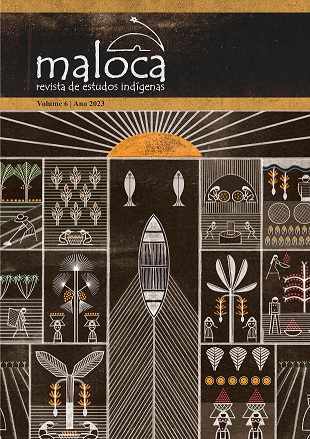Abstract
The study on Animate and inanimate categories reveals the animistic elements in Cashinahua philosophy whose concept of the world is based on the general notion of “indifferentiation” of beings. Their language shows morpho-syntactically how they conceive and organize (human and non-human) beings. Cashinahua linguistic expedients show that animate elements and some inanimate ones (such as rocks, arrows) may belong to the class of living beings, and as such are deemed capable of interacting like humans. Lexical category and its ethnosyntax role reflects its semantic category and its syntactic treatment in Cashinhua
References
CALAVIA SAEZ, O. 2000. “O Inca Pano: Mito, história e modelos etnológicos”. Mana 6 (2): 7-35.
https://www.scielo.br/j/mana/a/gz7SX8BVRy8BKkHtLQCGY9L/abstract/?lang=en
CAMARGO, E. 2003. “Classes lexicales : frontières peu tranchées en caxinaua”. Faits de Langues,
(J. Landaburu ed.) : Méso-Amérique, Caraïbes, Amazonie (2): 25-39.
CAMARGO, E. 2010. “Le cachinawa”. In : Dictionnaire des langues du monde (Peyraube A. &
Bonvini E. eds.). Presses Universitaires de France, 1577-1586.
CAMARGO, E. « 013. «Agentivité grammaticale et agentivité intrinsèque. Aspects de l’ethnosyntaxe
cachiawa (pano)». In: L’agentivité, Interactions, grammaire et narrativité, vol II, (V. Vapnarsky, A. Becquelin & M. de Fornel, éds.). Ateliers d’anthropologie 39. https://journals.openedition.org/ateliers/9251
CAMARGO, E. & TORIBIO, A. 2019. “Interacciones verbales entre los cashinahuas”. Bulletin de
l’IFEA, 48 (2): 1-22. https://journals.openedition.org/bifea/10588
CAMARGO, E., WAYANA, A. & TORIBIO, A. 2018. “Documentação de línguas e culturas indígenas”. Moara 50: 52-86. https://periodicos.ufpa.br/index.php/moara/article/view/6805
CAPISTRANO de ABREU, J. 1941 [1914]. Rã-txa hu-ni ku-in Grammática, textos e vocabulário
Caxinauás. Rio de Janeiro: Edição da Sociedade Capistrano de Abreu. Reeditado em 2017, Camargo (org.). Campinas: Editora da Unicamp.
DELEAGE, P. 2005. Le chamanisme sharanahua. Enquête sur l’apprentissage et l’épistémologie
d’un rituel. Tese de Doutorado. EHESS, Paris, França.
DESCOLA, Ph. 2015. Par-delà nature et culture. Paris: Gallimard. coll. Folio essais.
KEIFENHEIM, B. 1990. Nawa : “Un concept clé de l’altérité chez les Pano.” JSA 76 : 79-94. https://
www.persee.fr/doc/jsa_0037-9174_1990_num_76_1_1358
KENSINGER, K., 1995. How People Ought to Live. The Cashinahua of Eastern Peru. Boston: Waveland Press.
LAGROU, E., 2007. A fluidez da forma: arte, alteridade e agência em uma sociedade amazônica.
Rio de Janeiro: Topbooks.
LIMA, E., 2000. Com os olhos da serpente: Homens, animais e espíritos nas concepções Katukina sobre a natureza. Tese de Doutorado, USP, São Paulo, SP, Brasil. https://www.academia.
edu/1446414/Com_os_olhos_da_serpente_homens_animais_e_esp%C3%ADritos_nas_concep%C3%A7%C3%B5es_Katukina_sobre_a_natureza
McCALLUM, C. 2002. Incas e Nawas. Produção, transformação e transcendência na história
Kaxinawá. In: Pacificando o Branco. (B. Albert, A. Ramos eds.). 375-401pp. IRD Éditions, Emprensa Oficial SP/Unesp. https://books.openedition.org/irdeditions/24791?lang=fr
PEREZ-GIL, L. 2000. “O sistema médico Yawanáwa e seus especialistas: cura, poder e iniciação xamânica” Caderno Saúde Pública 17(2): 333-344. https://www.scielo.br/j/csp/a/BrpcRcnqZW3ryzfZSbj8Rnt/?lang=pt

This work is licensed under a Creative Commons Attribution-NonCommercial-ShareAlike 4.0 International License.
Copyright (c) 2024 Eliane Camargo

